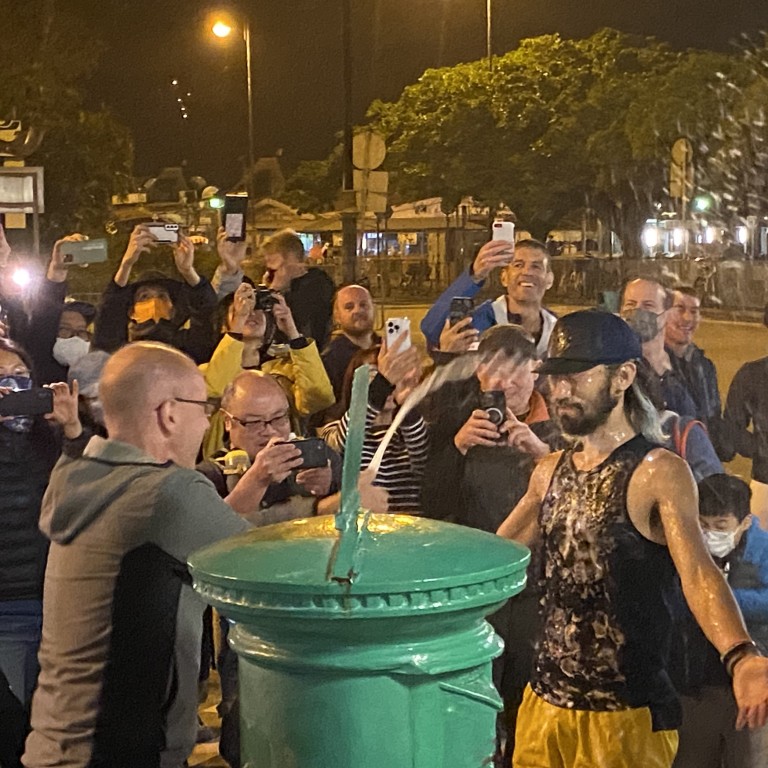
Hong Kong 298km Four Trails: Tomokazu Ihara’s incredible act of sportsmanship on way to second finish
- Ihara stops to help ‘cold, confused’ runner going in wrong direction, showing true spirit of the event over Lunar New Year
- ‘It wasn’t about the race any more,’ says Ihara, who still ‘finished’ for the second time, arriving at green postbox in Mui Wo first
Tomokazu Ihara was on his way to completing the 298km Hong Kong Four Trails Ultra Challenge (HK4TUC) for the second time when he saw a figure appear ahead of him.
It was Nugo Yamanath Limbu, a fellow Four Trails runner, who was for some reason going in the wrong direction during the epic run linking the four major trails in Hong Kong – the MacLehose, Wilson, Hong Kong and Lantau Trails.
The HK4TUC is a notoriously demanding undertaking. There are no checkpoints or support allowed on the trails, though runners can get help travelling between them.
There is also a 60-hour cut-off point to be a “finisher” and a 72-hour cut off to be a “survivor”. It took five years before anyone “finished” and a decade until anyone “finished” twice.
Despite organiser Andre Blumberg emphasising it is not a race, but a personal challenge with no winners, 45-year-old Japanese runner Ihara is – by his own admission – driven by the competition element of ultra running.
For him, the personal challenge was finishing twice, going faster than he did in 2019 and possibly even running under 50 hours.
So when he was on the Lantau Trail, and the end was near, Limbu’s appearance could have just been a momentary distraction from his goal. After all, Limbu is an experienced runner and a former “finisher” himself.
But Ihara put sportsmanship and care for his fellow runner above himself.
New film takes viewer on emotional journey along Hong Kong’s 4 trails
“He came from the wrong direction. So I’m looking at his face. It was not good,” Ihara said. “He was not in a good situation. He was very confused and I knew it wasn’t good. So we talked, he looked cold, he looked confused,” Ihara said.
The pair had been running for two days non stop, and the sleep deprivation was clearly getting to Limbu – the start time for the event had changed from morning to evening this year, so even the quickest runners went through two nights.
Limbu was shivering so Ihara gave him his jacket.
“I knew that I was in a race, but it was not about the race any more,” added Ihara, who thought he either needed to escort Limbu all the way back to the green postbox that marks the end of the HK4TUC, or perhaps to a road where spectators could look after him.
Hong Kong students to run for 12 hours in anti-slavery fundraiser
Limbu then got a phone call, which seemed to spark him back to life, and suddenly said “let’s race together”.
They ran together for a while but then Limbu went ahead and Ihara lost him in the fog on the mountains.
Ihara knew Limbu was a good runner. He assumed Limbu had a second wind and made it to the finish ahead of him. But when Ihara arrived at the green postbox in Mui Wo in 54 hours and two minutes, he soon realised he was the first.
“So it seems that I overtook him. Or he was lost or he had to stop somewhere,” Ihara said.
Blumberg heard about the incident and immediately made a point of praising Ihara for prioritising his fellow runners over his own performance.
Limbu reached the finish in 56:29 and the two runners embraced and exchanged stories of their epic runs. Limbu’s grim was spread across his face.
In 2019, Ihara was just the eighth ever finisher, completing the 298km in 57:42. This time, he wanted to go Sub-50. He targeted 13.5 hours on the MacLehose, 15 on the Wilson Trail, seven on the Hong Kong Trail and 11 hours on the Lantau Trail.
It went well for the first half, but then he got stomach issues and began to lose time. Overall though it was easier because he knew the trails and the route this time.
It was more than just the challenge of going faster that drew Ihara back, though – it was the uniqueness of the event.
Ihara has raced 100 miles or longer 65 times since 2011. When he started out, he was doing nine 100 mile races per year – quite something, even in the surreal realm of ultra running.
“I think the Four Trails has a very, very unique sequence,” he said. “It is a very unique type compared to other ultras. It’s not a race. It’s very long. It’s almost twice as long as 100 miles.
“You need to rely on yourself. Things can go wrong and even though things like the MTR or the ferry don’t change … It gives you a kind unique challenge that you can achieve.”

